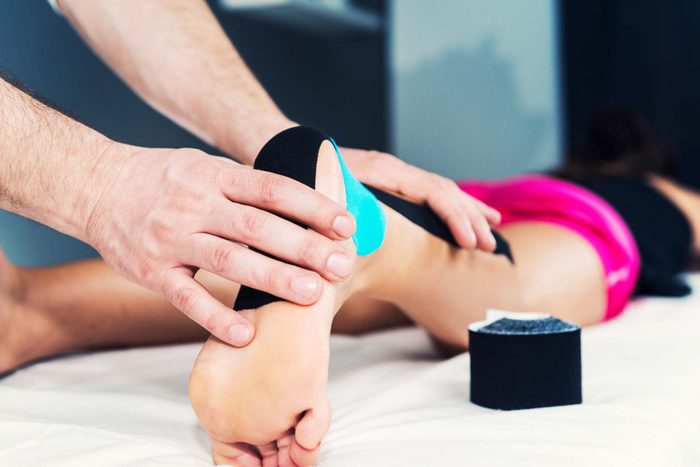Finding the right pain solution
In some areas of the United States, opioid overdoses have jumped by as much as 70 percent in recent years. That’s why doctors and patients are approaching pain management with more caution these days, but that doesn’t mean you should suffer—or worry about developing a dependence on your drugs. Use these questions to get the right treatment for your pain.

What triggers my pain symptoms?
If your pain isn’t coming from an obvious source—a sore neck from a car accident, say, or broken leg from a skiing snafu—try to pinpoint the trouble by keeping a pain journal, says Jeremy Allen, DO, a family medicine doctor in Birmingham, Alabama. Record what you were doing and what was happening around the onset of pain. “Even things as simple as a shift in your diet, a reduction in the amount or quality of sleep you get, or amount of stress you’re under can impact your level of pain,” says Dr. Allen. (Learn how to use a pain scale to assess your pain.)

What is my diagnosis?
All you know is that you’re in pain and want relief. But don’t forget: Pain is often a symptom, not a diagnosis. “It’s important to know that your doctor has a good understanding of the underlying cause of your pain,” says Jacob “Gus” Crothers, MD, national medical director at Groups Recover Together in the Portland, Maine area. “Without a correct diagnosis, it’s difficult to prescribe the best treatment.” Lacking a clear diagnosis? Consider getting a second opinion before starting any pain meds.

Are you treating me for acute pain or chronic pain?
Acute pain comes on suddenly and begins to ease once you start the healing process. Chronic pain, on the other hand, is ongoing and usually lasts longer than six months. It’s critical to understand the expected time frame of your pain and treatment. “Acute pain and chronic pain are managed very differently and there are certain strategies that might work for one but won’t work for the other,” says Dr. Crothers.

Have you considered all my medications and other health conditions?
Some medicine combos just don’t play nice in the body and can create more trouble. Research, including a study published in 2017 in the Scandinavian Journal of Pain, shows that some drugs will be stronger or weaker in the presence of other pharmaceuticals, causing the prescribed doses to be too high or too low. A bad cocktail of medication that includes opioids can also result in serious side effects. “Opioid pain medications, in particular, can cause trouble if they are mixed with another medication that is processed by the same part of the liver,” says Dr. Allen. “The two substances will end up receiving uneven amounts of critical enzymes that the body uses to process them, which could lead to inconsistent performance of both drugs or a buildup of those substances in the body.”

What’s the best way to approach pain management?
The current “best practice” for pain management is to start with a non-opioid pain reliever such as acetaminophen, plus a non-steroidal anti-inflammatory drug like ibuprofen or perhaps a medication such as gabapentin or pregabalin, says Eugene Viscusi, MD, director of acute pain management at Jefferson University Hospitals in Philadelphia, Pennsylvania. “Opioids should be added to this on an as-needed basis. The key is to use the lowest effective dose for the shortest amount of time,” says Dr. Viscusi. Talk to your doctor about your exit strategy to deal with any possible withdrawals. (Learn what anti-inflammatory foods can help reduce the pain too.)

Can I try non-opioid treatments first?
Back pain from a sprain or strain is a very common complaint, but pain stemming from the back or any other part of the body doesn’t necessarily need an opioid prescription, says Anh Quan Nguyen, DO, a pain specialist with Kaiser Permanente in Orange, California. Acute and chronic pain can resolve with non-medication treatments such as physical therapy, acupuncture or massage, and over-the-counter anti-inflammatories like ibuprofen, naproxen, and acetaminophen. “Other options include anti-inflammatories that are prescription strength or oral steroids such as prednisone if severe and without contraindications,” says Dr. Nguyen.

I don’t want to take Rx meds: What other options do I have?
Pharmaceuticals shouldn’t always be the first course of action taken to manage pain. “What many people don’t realize is that often, pain can be very poorly treated with prescription medications, but respond well to over-the-counter medications,” says Dr. Allen. Before taking the prescription opioid route, there may be lifestyle changes you can try to reduce your pain, such as yoga, meditation, weight loss, and exercise.

I’m doing physical therapy. Why do I still need pain meds?
Physical therapy can “hurt so good,” meaning it may be painful to do physical therapy, but the end results will help manage your pain. “Medications can help facilitate physical therapy and alleviate the process of inflammation that can trigger during a physical therapy session,” says Anita Gupta, DO, an anesthesiologist and pain specialist. Talk to your doc and physical therapist to make sure both are on the same page. Doing so will ensure “the end result is what both sides want and expectations are reachable,” says Dr. Gupta.

What are some common side effects of taking pain meds?
Side effects will vary from person to person. Any medication can carry unpleasant side effects like weight gain, fatigue, dry mouth, and nausea. Ask your doc about your meds’ most common side effects, and be sure to discuss the rare ones so you’ll have a better idea of what to watch out for. “For example, short-acting pain medications, meant to be used for a short duration of time, can lead to a rebound pain effect if taken for too long,” says Dr. Allen. “Some medications can also cause digestive issues, liver problems, and impaired adrenal function.” (These are the secrets addiction counselors want you to know.)

What if I re-injure myself? Can I take leftover opioids from my last bout?
Opioids are a controlled substance for a reason. They are can be very dangerous when not used under the direction and care of your doc. If that old knee injury is wreaking havoc on your daily life, don’t start popping the pills from your last episode six months ago. “The underlying pain from one injury may not be the same as for a second type of pain, or even the right medication for a similar type of pain,” says Asher Goldstein, MD, a pain specialist with Genesis Pain Management in New York, New York.
It’s also important to dispose of leftover, unwanted, or expired meds properly. “Many municipalities have put into place a means of disposal of medication so they do not get into our drinking water,” says Dr. Asher. You can contact your local pharmacy for information on disposing of specific drugs. Besides protecting the environment, proper disposal also keeps dangerous drugs out of the hands of others who may take them accidentally or for recreational purposes. The DEA National Rx Take Back Day, an initiative from the Drug Enforcement Administration, provides further information to safely dispose of prescription meds.

Can I become addicted to pain pills?
In a word, yes. “Patients need to know that it is a possible risk particularly with long term use and in patients that have risk factors,” says Medhat Mikhael, MD, a pain management specialist and medical director of the Orange Coast Medical Center for Spine Health in Fountain Valley, California. There are screening tools your doctor may use to assess your risk for addiction, Dr. Mikhael says. Those risks include struggles with alcohol, smoking, or other substance abuse. But research suggests those screening tools aren’t necessarily effective. A review of research published in 2019 in JAMA found that there are few valid ways for doctors to determine if a patient can be safely prescribed opioids.

What is opioid withdrawal syndrome?
A potentially life-threatening condition, opioid withdrawal syndrome can occur when a person who is dependent on opioids suddenly reduces or stops taking the drug. Not everyone will experience withdrawal symptoms from taking opioids. It will depend on the length of treatment and the dose of the opioids, says Dr. Viscusi. “Symptoms may be as little as mild flu-like symptoms to severe nausea, vomiting, diarrhea, anxiety, general body aches, and pains.”

Should I request an Rx for naloxone?
According to the Centers for Disease Control and Prevention, almost seven out of ten drug overdose deaths in the U.S. involve an opioid. The majority of those deaths are unintentional, says Ilan Danan, MD, a sports neurologist and pain management specialist at Cedars-Sinai Kerlan-Jobe Institute in California. “In situations such as these, having an opioid emergency plan is an honest discussion worth having between the patient and the prescribing physician,” he says. That’s where Naloxone, a life-saving drug that’s used to reverse the effects of an opioid overdose, comes in. “It is imperative that patients and family members understand the signs and symptoms of an opioid drug overdose, as Naloxone could be lifesaving,” says Dr. Danan. It’s important to have Naloxone on hand not only to prevent personal or patient overdose, but also in case children or someone the medication is not prescribed for gets access to it.
Next, check out the 24 secrets your pain doctor won’t tell you.
